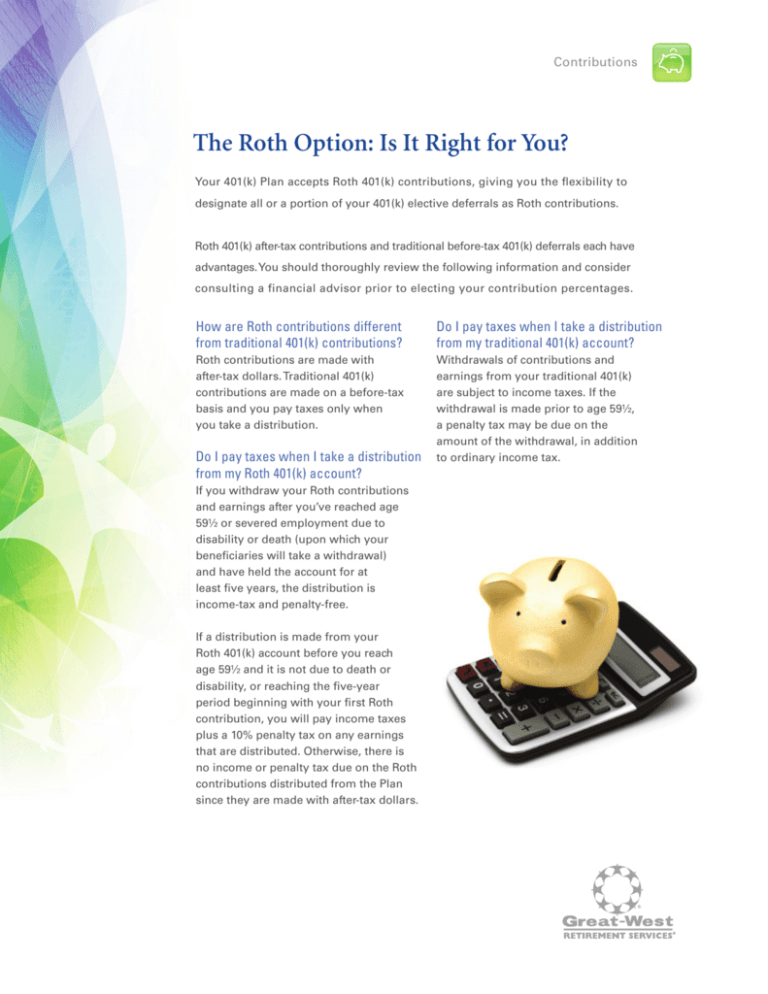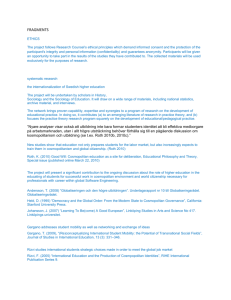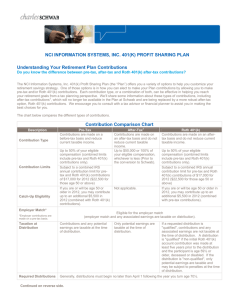
Contributions
The Roth Option: Is It Right for You?
Your 401(k) Plan accepts Roth 401(k) contributions, giving you the flexibility to
designate all or a portion of your 401(k) elective deferrals as Roth contributions.
Roth 401(k) after-tax contributions and traditional before-tax 401(k) deferrals each have
advantages. You should thoroughly review the following information and consider
consulting a financial advisor prior to electing your contribution percentages.
How are Roth contributions different
from traditional 401(k) contributions?
Do I pay taxes when I take a distribution
from my traditional 401(k) account?
Roth contributions are made with
after-tax dollars. Traditional 401(k)
contributions are made on a before-tax
basis and you pay taxes only when
you take a distribution.
Withdrawals of contributions and
earnings from your traditional 401(k)
are subject to income taxes. If the
withdrawal is made prior to age 59½,
a penalty tax may be due on the
amount of the withdrawal, in addition
to ordinary income tax.
Do I pay taxes when I take a distribution
from my Roth 401(k) account?
If you withdraw your Roth contributions
and earnings after you’ve reached age
59½ or severed employment due to
disability or death (upon which your
beneficiaries will take a withdrawal)
and have held the account for at
least five years, the distribution is
income-tax and penalty-free.
If a distribution is made from your
Roth 401(k) account before you reach
age 59½ and it is not due to death or
disability, or reaching the five-year
period beginning with your first Roth
contribution, you will pay income taxes
plus a 10% penalty tax on any earnings
that are distributed. Otherwise, there is
no income or penalty tax due on the Roth
contributions distributed from the Plan
since they are made with after-tax dollars.
Contributions
How do Roth 401(k) after-tax contributions affect my take-home pay?
Roth 401(k) contributions reduce your take-home pay because you pay taxes
on your Roth 401(k) contribution up front, rather than deferring those taxes
until you take a distribution.
For example, let’s assume you earn $40,000 annually and pay income tax
at the assessment rate of 25%. If you contribute $5,000 before tax to a
traditional 401(k) plan, you don’t pay income tax on the $5,000 contribution.
Your take-home pay is $26,250, which is greater than it would be if you
had made an after-tax contribution. If you make a $5,000 Roth 401(k)
contribution, you pay income taxes on that $5,000 immediately. Assuming a
25% tax rate, your take-home pay is only $25,000. That amounts to $1,250
less in take-home pay when you contribute to the Roth 401(k) account.
Before-Tax 401(k)
Roth After-Tax 401(k)
Annual Salary
$40,000
$40,000
Minus Before-Tax Contributions
$5,000
$0
Taxable Pay
$35,000
$40,000
Minus Estimated Income Tax
$8,750
$10,000
Minus After-Tax Contributions
$0
$5,000
TAKE-HOME PAY
$26,250
$25,000
How much can I contribute?
The maximum combined contribution limit in 2009 is $16,500. If you are age 50 or older,
you can make additional “catch-up” contributions of $5,500.
How does the Roth 401(k) differ from a Roth IRA?
Contribution Limits
Roth IRA contributions are limited to $5,000 in 2009 (or $6,000 if you are
age 50 or older) versus $16,500 for the Roth 401(k) (or $22,000 if you are
age 50 or older). So, you can contribute more on an after-tax basis to
your Roth 401(k) than to a Roth IRA.
Eligibility
If you’re single and earn more than $120,000 a year or are married
with a joint income of more than $176,000 in 2009, you aren’t eligible
to contribute to a Roth IRA in 2009. However, if you meet your Plan’s
eligibility requirements, you can participate in the Roth 401(k) Plan
regardless of your income.
Contributions
Can my employer make matching contributions?
Yes.Your employer can make matching contributions to your Roth 401(k) account. However, any
employer-matching contributions to your Roth 401(k) are before-tax contributions and are
treated the same as traditional 401(k) matching contributions, which are subject to taxes
when you take a distribution.
Can I roll over my account if I change employers?
Should you leave your current employer, you still have the option of rolling over your
Roth 401(k) account to a Roth IRA or to a 401(k) or 403(b) plan that has a designated Roth
account and accepts Roth rollovers. You can roll over your traditional 401(k) account to
any eligible traditional IRA, qualified 401(k) plan, 403(b) plan or governmental 457(b) plan
that accepts rollovers.
Can I leave my money in my Roth 401(k) indefinitely?
Once you reach age 70½, the government requires that you begin taking minimum distributions.
AT-A-GLANCE COMPARISON
Is my contribution taxable
Before-Tax 401(k)
Roth After-Tax 401(k)
No
Yes
Yes
No
Yes
No, provided the distribution
in the year I make it?
Is my contribution taxed
when distributed?
Are the earnings on my
contributions taxed when
occurs after age 59½, death
distributed?
or disability and no earlier
than five years after your first
Roth 401(k) contribution
If I change jobs can I roll
Yes, to a qualified 401(k)
Yes, to a Roth IRA, 401(k) plan
over my account?
plan, traditional IRA, 403(b)
or 403(b) plan if the plan has a
plan or governmental
designated Roth account and
457(b) plan if the plan
accepts rollovers
allows it
What is the maximum
Combined limit for contributions in 2009: $16,500 or $22,000
amount I can contribute?
including the additional $5,500 Age 50+ Catch-Up contribution
If I experience a hardship,
Yes, if your Plan allows
Yes, if your Plan allows
can I make a withdrawal?
hardship withdrawals
hardship withdrawals
Do I have to take a minimum
Yes
Yes
distribution at age 70½?
Contributions
Making the Best Choice for You
You will have to determine whether contributing to your Plan on an after-tax
Roth basis or a traditional before-tax basis makes more sense for your situation.
The Roth 401(k) option essentially “locks in” today’s tax rates on all contributions.
For some people—especially those who expect to be in a higher tax bracket when
they retire—the Roth 401(k) option may make the most sense. If you’re one of
those people, the Roth option allows you to pay taxes on your contributions
when they are contributed (presumably at a lower tax rate than you would
expect to pay at retirement).
If you expect to be in a lower tax bracket when you retire, you might want to
consider contributing to your 401(k) on a before-tax basis. You won’t pay taxes
on your contributions or any earnings on your contributions until you take a
distribution, which is usually at retirement (when many people expect their
retirement earning power and tax burden to be lower than it is today).
Roth 401(k) vs. Traditional 401(k): Illustrating the Difference
Assumptions:
Current Age
45
Annual Salary
$35,000
Contribution (traditional before tax)
6%
Contribution (Roth post-tax)
4.5%
Salary Growth Rate
2% annually
Pre-Retirement Rate of Return
8%
Retirement Age
65
Years in Retirement
15
Post-Retirement Rate of Return
6%
In order to keep your take-home pay the same, your Roth contribution will be less than a
traditional before-tax contribution because Roth contributions are made on an after-tax basis.
These assumptions support the charts on the following pages ...
Contributions
Example 1
For an investor at age 45 with a 25% tax rate who plans to retire at age 65
with a 15% tax rate, the traditional 401(k) provides a higher expected income.
Balance at Retirement
Expected After-Tax Income1
Example 2
For an investor at age 45 with a 25% tax rate who plans to retire at age 65 with the same
25% tax rate, the traditional 401(k) and Roth 401(k) provide the same expected income.
Balance at Retirement
Expected After-Tax Income1
Key
These are hypothetical examples and are not intended to represent past or future
performance of a specific investment, which cannot be predicted or guaranteed, or
to provide specific advice to any individual. Rates of return will vary over time. Those
investments offering a higher rate of return also involve a higher degree of risk.
FOR ILLUSTRATIVE PURPOSES ONLY.
= Traditional 401(k)
= Roth 401(k)
Contributions
Example 3
For an investor at age 45 with a 25% tax rate who plans to retire at age 65
with a 35% tax rate, the Roth 401(k) provides a higher expected income.
Balance at Retirement
Expected After-Tax Income1
The Bottom Line: Participate!
Regardless of which type of contributions you choose, the important thing is to contribute as
much as you can today for your retirement tomorrow. If after you’ve done your research and
consulted the experts you decide that Roth 401(k) contributions are right for you, can make the
appropriate changes to your account by completing a Salary Deferral Agreement form available
from your company’s human resources department, or by visiting your Plan’s Web site or
calling KeyTalk®.2 If you are not currently enrolled in your Plan, you can elect to make Roth
401(k) contributions by completing your Plan’s enrollment form.
For more information about the Roth 401(k), please contact your Plan representative.
1 The expected retirement income for the traditional 401(k) account is determined by converting the retirement balance into an annuity at the post-retirement return rate for 15 years. The annuity is
reduced by the tax rate in retirement. The expected retirement income for the Roth 401(k) account is determined by converting the retirement balance into an annuity at the post-retirement return rate for
15 years. The annuity is decreased by the value of the annuitized before-tax premium amount.
2 Access to KeyTalk and the Web site may be limited or unavailable during periods of peak demand, market volatility, systems upgrades/maintenance or other reasons.
Securities, when offered, are offered through GWFS Equities, Inc. and/or other broker dealers.
Great-West Retirement Services ® refers to products and services provided by Great-West Life & Annuity Insurance Company, FASCore, LLC (FASCore Administrators, LLC in California), First
Great-West Life & Annuity Insurance Company, White Plains, New York, and their subsidiaries and affiliates. Great-West Life & Annuity Insurance Company is not licensed to conduct business in New
York. Insurance products and related services are sold in New York by its subsidiary First Great-West Life & Annuity Insurance Company. Other products and services may be sold in New York by FASCore,
LLC. GWFS Equities, Inc. is a wholly owned subsidiary of Great-West Life & Annuity Insurance Company and an affiliate of FASCore, LLC (FASCore Administrators, LLC in California) and First Great-West
Life & Annuity Insurance Company, White Plains, New York. Great-West Retirement Services ®, KeyTalk ® and the Partnership Logo are service marks of Great-West Life & Annuity Insurance Company.
©2008 Great-West Life & Annuity Insurance Company. All rights reserved. Form# C51187 (k and bsg) (12/08) PT66914






